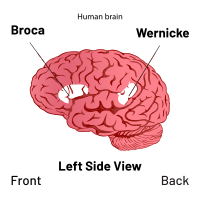
Photo from wikipedia
PURPOSE Constraint-induced language therapy (CILT) is an aphasia treatment that incorporates neuroplasticity principles of forced verbal use and high-intensity training to facilitate language recovery in individuals with stroke-induced aphasia (Pulvermüller… Click to show full abstract
PURPOSE Constraint-induced language therapy (CILT) is an aphasia treatment that incorporates neuroplasticity principles of forced verbal use and high-intensity training to facilitate language recovery in individuals with stroke-induced aphasia (Pulvermüller et al., 2001). The burgeoning CILT literature has led to systematic reviews (SRs) that summarize treatment results. In this project, we appraised the quality and examined findings reported in several SRs to draw conclusions about the effectiveness of CILT. METHOD We searched multiple databases for SRs that summarized CILT research for poststroke aphasia. We identified six SRs, among which three summarized findings qualitatively and three included meta-analysis (MA) to quantify results. We rated each SR for methodologic quality using the A MeaSurement Tool to Assess Systematic Reviews (AMSTAR 2; Shea et al., 2017) and extracted findings across the six SRs. RESULTS Two reviewers reliably applied the AMSTAR 2 to the six SRs. Although the six SRs generally were conducted with satisfactory rigor, each was lacking two or more critical domains. Descriptive summaries in SRs reported positive effects of CILT for language and communication measures. However, the three MAs showed that effects of CILT often did not surpass those of comparison treatments for naming, comprehension, and repetition measures. MA findings were positive in a review that included all research designs and evaluated treatment effects for trained naming items. Generalized CILT effects for standardized language measures were limited in two other MAs. CONCLUSIONS CILT led to improvements in a variety of language and communication measures. When compared with intensive multimodality treatments, CILT effects were similar, suggesting that training intensity may be the potent factor in CILT outcomes. Future SRs should be implemented with increased rigor across quality rating scale domains to increase confidence in conclusions.
Journal Title: American journal of speech-language pathology
Year Published: 2023
Link to full text (if available)
Share on Social Media: Sign Up to like & get
recommendations!